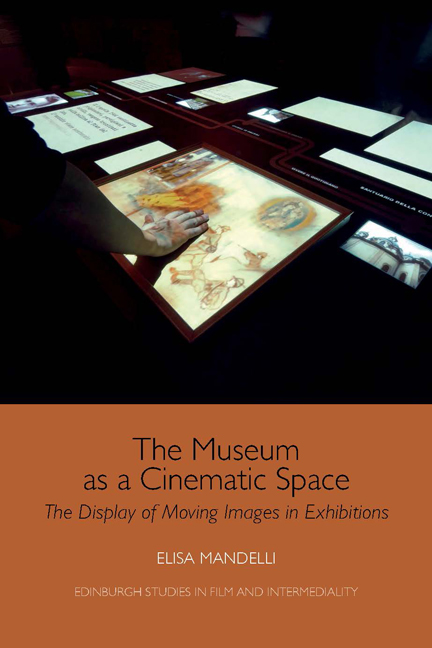Book contents
- Frontmatter
- Contents
- List of Figures
- Acknowledgements
- Preface
- Introduction
- Part I Between History and Modernity: Films in Exhibitions in the Twentieth Century
- Part II The Museum as a Cinematic Space: Museums and Moving Images in the Twenty-first Century
- 5 From the Museum Experience to the Museum as an Experience
- 6 Audio-visuals in Exhibitions
- 7 The Museum and its Spectres
- 8 A Walk through Images
- 9 New Interpretations of the Movie Theatre
- 10 Touching Images
- Conclusions
- Bibliography
- Index
10 - Touching Images
from Part II - The Museum as a Cinematic Space: Museums and Moving Images in the Twenty-first Century
Published online by Cambridge University Press: 24 October 2019
- Frontmatter
- Contents
- List of Figures
- Acknowledgements
- Preface
- Introduction
- Part I Between History and Modernity: Films in Exhibitions in the Twentieth Century
- Part II The Museum as a Cinematic Space: Museums and Moving Images in the Twenty-first Century
- 5 From the Museum Experience to the Museum as an Experience
- 6 Audio-visuals in Exhibitions
- 7 The Museum and its Spectres
- 8 A Walk through Images
- 9 New Interpretations of the Movie Theatre
- 10 Touching Images
- Conclusions
- Bibliography
- Index
Summary
Audience interaction is today considered an essential feature of museums that aspire to be cutting-edge and attractive. In particular, in recent exhibitions, screens can often be touched and serve as an interface between viewers and contents. Interactive kiosks, which remain to this day an occasionally encumbering presence among the artefacts and artworks, are being replaced by devices that tend to hide their technological component in favour of forms of interaction that aim to be as spontaneous as possible.
The impact of interactive devices on the configuration of contemporary exhibitions is at least two-fold. First, it underscores the tactile dimension of reception, whose influence on museum history has been more pervasive than is usually recognised. The interdiction of touch in the museum context is a relatively recent phenomenon, which intervened progressively after the eighteenth century. In previous centuries, touching the objects was common practice for the visitors of both public and private collections: merely looking at the exhibits was considered superficial, and it was believed that only through physical contact could one fully experience them. However, the museum perception was later identified tout court with the sense of sight, to the point that, as noted by Susan Stewart, museums are conceived in such a natural way as ‘empires of sight’ that rarely happens to imagine that their fruition can take place through other senses. However, considered in relation to the display of moving images, this supremacy of the sight reveals to be less pervasive than one might imagine. From the Mutoscopes of the Imperial War Museum, activated by turning a handle, to the interactive tables we will discuss in this chapter, which function thanks to the touch, moving images in museums often solicit the tactile involvement of the visitors.
Wanda Strauven identifies the origins of the ‘tactile’ tradition in the practice of touching the exhibits of private collections back in the second half of the seventeenth century, before their gradual institutionalisation.
- Type
- Chapter
- Information
- The Museum as a Cinematic SpaceThe Display of Moving Images in Exhibitions, pp. 124 - 136Publisher: Edinburgh University PressPrint publication year: 2019



